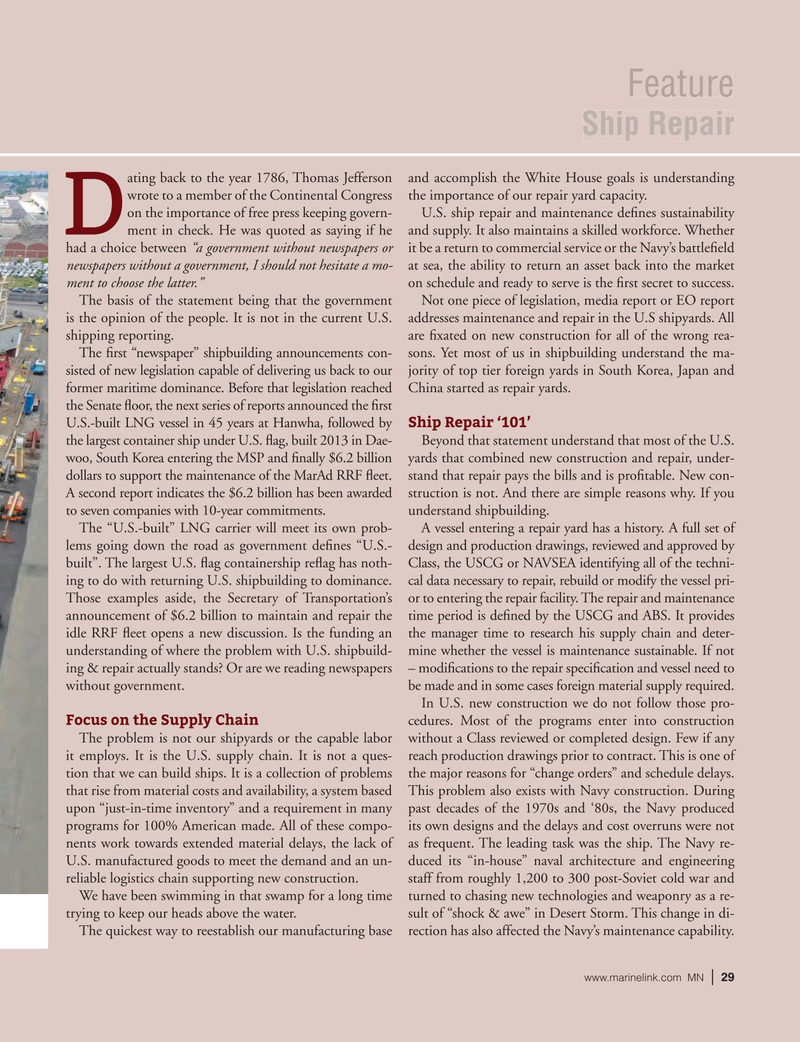
Page 29: of Marine News Magazine (September 2025)
Read this page in Pdf, Flash or Html5 edition of September 2025 Marine News Magazine
Feature
Ship Repair ating back to the year 1786, Thomas Jefferson and accomplish the White House goals is understanding wrote to a member of the Continental Congress the importance of our repair yard capacity. on the importance of free press keeping govern- U.S. ship repair and maintenance de? nes sustainability
D ment in check. He was quoted as saying if he and supply. It also maintains a skilled workforce. Whether had a choice between “a government without newspapers or it be a return to commercial service or the Navy’s battle? eld newspapers without a government, I should not hesitate a mo- at sea, the ability to return an asset back into the market ment to choose the latter.” on schedule and ready to serve is the ? rst secret to success.
The basis of the statement being that the government Not one piece of legislation, media report or EO report is the opinion of the people. It is not in the current U.S. addresses maintenance and repair in the U.S shipyards. All shipping reporting. are ? xated on new construction for all of the wrong rea-
The ? rst “newspaper” shipbuilding announcements con- sons. Yet most of us in shipbuilding understand the ma- sisted of new legislation capable of delivering us back to our jority of top tier foreign yards in South Korea, Japan and former maritime dominance. Before that legislation reached China started as repair yards. the Senate ? oor, the next series of reports announced the ? rst
U.S.-built LNG vessel in 45 years at Hanwha, followed by Ship Repair ‘101’ the largest container ship under U.S. ? ag, built 2013 in Dae- Beyond that statement understand that most of the U.S. woo, South Korea entering the MSP and ? nally $6.2 billion yards that combined new construction and repair, under- dollars to support the maintenance of the MarAd RRF ? eet. stand that repair pays the bills and is pro? table. New con-
A second report indicates the $6.2 billion has been awarded struction is not. And there are simple reasons why. If you to seven companies with 10-year commitments. understand shipbuilding.
The “U.S.-built” LNG carrier will meet its own prob- A vessel entering a repair yard has a history. A full set of lems going down the road as government de? nes “U.S.- design and production drawings, reviewed and approved by built”. The largest U.S. ? ag containership re? ag has noth- Class, the USCG or NAVSEA identifying all of the techni- ing to do with returning U.S. shipbuilding to dominance. cal data necessary to repair, rebuild or modify the vessel pri-
Those examples aside, the Secretary of Transportation’s or to entering the repair facility. The repair and maintenance announcement of $6.2 billion to maintain and repair the time period is de? ned by the USCG and ABS. It provides idle RRF ? eet opens a new discussion. Is the funding an the manager time to research his supply chain and deter- understanding of where the problem with U.S. shipbuild- mine whether the vessel is maintenance sustainable. If not ing & repair actually stands? Or are we reading newspapers – modi? cations to the repair speci? cation and vessel need to without government. be made and in some cases foreign material supply required.
In U.S. new construction we do not follow those pro-
Focus on the Supply Chain cedures. Most of the programs enter into construction
The problem is not our shipyards or the capable labor without a Class reviewed or completed design. Few if any it employs. It is the U.S. supply chain. It is not a ques- reach production drawings prior to contract. This is one of tion that we can build ships. It is a collection of problems the major reasons for “change orders” and schedule delays. that rise from material costs and availability, a system based This problem also exists with Navy construction. During upon “just-in-time inventory” and a requirement in many past decades of the 1970s and ‘80s, the Navy produced programs for 100% American made. All of these compo- its own designs and the delays and cost overruns were not nents work towards extended material delays, the lack of as frequent. The leading task was the ship. The Navy re-
U.S. manufactured goods to meet the demand and an un- duced its “in-house” naval architecture and engineering reliable logistics chain supporting new construction. staff from roughly 1,200 to 300 post-Soviet cold war and
We have been swimming in that swamp for a long time turned to chasing new technologies and weaponry as a re- trying to keep our heads above the water. sult of “shock & awe” in Desert Storm. This change in di-
The quickest way to reestablish our manufacturing base rection has also affected the Navy’s maintenance capability.
www.marinelink.com MN 29|

 28
28

 30
30
